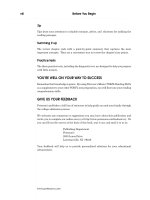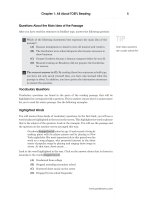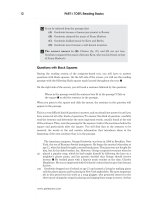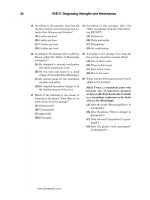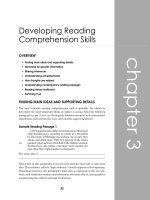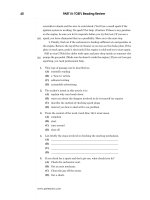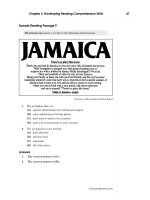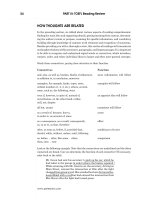Peterson’s master toefl reading skills part 31 pps
Bạn đang xem bản rút gọn của tài liệu. Xem và tải ngay bản đầy đủ của tài liệu tại đây (65.59 KB, 7 trang )
Appendix B: Applying to Colleges and Universities in the U.S. 201
www.petersons.com
• Financial aid is awarded at the beginning of the academic year (August–Septem-
ber) and is rarely available for students entering in January. Note: Aid is more
likely to be available to first-year students than to those transferring from other
institutions. If you are already enrolled in a university at home and wish to transfer
to a university in the United States, ask the admission office about its policy on
financial aid for international transfer students.
• You may be able to negotiate a loan to cover part of your education. Your
educational adviser will have a list of reputable loan programs for which you are
eligible. These loans usually require both a creditworthy U.S. citizen to act as a
cosigner and proof of enrollment in a U.S. university. Before taking a loan, make
sure you know how you are going to repay it and how a loan will affect your plans
for graduate study and returning home.
• Working can help pay part of your education. However, immigration regulations
permit international students to work only part-time and only on campus. After
your first year of study, you may apply to the Bureau of U.S. Citizenship and
Immigration Services (USCIS) (formerly INS) for permission to work off campus,
but there is no guarantee that this will be granted and you cannot work off campus
for more than twelve months. Understanding the various regulations from the
USCIS can be difficult, so you should carefully review the information found at
/>08_TOEFLReadingAppB,177-206 7/29/06, 12:53201
202 PART V: Appendixes
www.petersons.com
TIPS FROM THE EXPERTS
Here are some questions that international education advisers in various countries are
frequently asked about studying in the U.S.
When should I start the application process if I am interested in studying
in the U.S.?
You should start the application process a year and a half before your
planned arrival at a U.S. college campus. The academic year generally runs
from September to May or June. So if you plan to enroll in September, you
should begin contacting schools in March, April, or May of the previous year.
What are the best colleges in the U.S.?
“Best” is a relative term. In the U.S. there is a very wide range of colleges
offering diverse opportunities. What is best for you may not be best for
another student. It is not advisable to go by so-called ranking only. You
need to make a list of your own priorities, do a realistic self-assessment, and
then do research in order to find the “best” colleges for you.
How does one select a U.S. college or university?
Students select institutions based on some combination of the following:
their academic and career goals; the type of institution they want (specialized
colleges, liberal arts colleges, institutes of technology, colleges with a reli-
gious affiliation, single-gender colleges); the availability, level, and quality
of programs in their fields of interest and specializations; the geographic
location and setting (rural, suburban, or city-based); climate; costs; the
nature of and availability of financial aid; size (number of students and
student-faculty ratio); diversity on campus (including the number of interna-
tional students); availability of special programs such as interdisciplinary
studies and internship opportunities; and student life and campus activities.
What do colleges look for when making their admission decisions?
Colleges look for a variety of factors, such as a good academic record,
English language proficiency, acceptable standardized test scores, an
effective statement of purpose or essay, strong letters of recommendation,
proof of financial support, and other program-specific requirements.
Does the U.S. welcome international students?
The U.S. is known for its diversity of peoples and cultures. U.S. universities
value the perspectives brought to their classrooms and research and
heartily welcome international students.
What attracts international students to higher education in the U.S.?
International students are attracted to the availability of a large variety of
majors and specializations, the U.S. system of accreditation, flexibility in the
08_TOEFLReadingAppB,177-206 7/29/06, 12:53202
Appendix B: Applying to Colleges and Universities in the U.S. 203
www.petersons.com
educational system, merit-based admission and financial assistance, and
the marketability of the degree. Students enjoy their experience in a proven
educational system in a country with a diverse culture and a modern outlook.
What is the cost of higher education in the U.S.?
The cost of studying at a U.S. college or university is anywhere from
$20,000 to more than $50,000 per year. This includes tuition, fees (includ-
ing computer, lab, or other facilities usage), food, and on-campus or off-
campus housing. Additional expenses include books and supplies, trans-
portation, insurance, and personal expenses.
What financial aid opportunities are available for international students?
Financial aid is very competitive at the undergraduate level. Scholarships,
which are given to top students only, are very rare for international students.
Financial assistance from foundations, organizations, and the U.S. govern-
ment is also rarely awarded to international undergraduate students. Less
than 5 percent of international undergraduates are financed through these
sources. Your educational adviser will be able to tell you whether there are
special funds available for students from your country.
What tests do I need to take and what are the minimum scores required for
admission?
Many colleges and universities require the SAT or the ACT Assessment for
undergraduate admission. Also, international students whose native lan-
guage is not English are required to take an English language proficiency
test. The Test of English as a Foreign Language (TOEFL) is the most widely
accepted test. There are many competitive colleges and universities that
require SAT Subject Test scores in addition to the SAT. The Subject Tests
are in subjects such as biology, history, math, chemistry, and physics. You
need to check with the colleges and universities you are applying to and ask
if they require any Subject Tests.
Each college or university has different score requirements for standardized
tests. You can strengthen your application by obtaining excellent scores.
When should I take the tests?
When applying for standardized tests, keep in mind the time period during
which the test scores will be valid. For instance, TOEFL scores are valid for
only two years. Try to take tests by October if you plan to study in the
United States in September of the following year. Another thing to take
into consideration is that many colleges have financial aid deadlines as
early as December, January, or February for enrollment in September, and
if you are applying for financial aid, you must make sure that all items in
your application packet, including your test scores, reach the colleges and
universities of your choice before then. But do not take a test unless you feel
prepared to do so. Time yourself and take a lot of practice tests to get used
to the pattern of questions and the timing.
08_TOEFLReadingAppB,177-206 7/29/06, 12:53203
204 PART V: Appendixes
www.petersons.com
How important are standardized test scores?
Standardized test scores are only one part of the application procedure and
not the sole decision-making factor in the admissions process. They are a
valuable tool in assessing the potential of students applying from varied
educational backgrounds to succeed in the higher educational system of the
U.S. While the format of each test varies, most focus on measuring the
verbal, analytical, problem-solving, and quantitative skills of students.
The level of skills required in a particular program may vary by the field of
study and by the school or department. The ability of an international
student to succeed in a particular program or school is determined only
after a comprehensive review of the entire application packet.
What is a grade point average?
A grade point average (GPA) is the most common method of measuring a
student’s academic performance. For each course, grades are awarded on a
scale of A to D and F. At the end of each term, letter grades are converted into
numerals on a 4.0 scale (A = 4, B = 3, C = 2, D = 1, F = 0) and each numeral
grade is multiplied by the number of credits each course is worth. These
numbers are added together and then divided by the total number of credits
taken to determine the student’s GPA for that term. A GPA is calculated for
each term, cumulated each year, and a final GPA is calculated. (Note: Most
programs use a GPA scale of 4.0, although a few schools use a scale of 5.0.)
A C average or better is generally expected of undergraduate students.
What are credits?
Students receive their degree by completing a specified number of credits.
One credit is roughly equivalent to one hour of class time per week. Each
course earns a specified number of credits (usually 3 or 4). Sometimes the
terms “semester hours,” “quarter hours,” or “units” are used instead of
“credits” or “credit hours.”
What is the academic year for colleges in the U.S.?
The academic year usually runs from mid-August to the end of May.
However, it varies for each college or university. It may be divided into
semesters, quarters, or trimesters. In addition, many schools provide a
summer term of six to eight weeks. Students sometimes take summer
courses to lower their course load during the regular terms or to earn their
degrees more quickly. There are at least two main breaks during the
academic year: two to four weeks in December and January and about a
week in the spring (called Spring Break).
What is the difference between applying for the fall and spring semesters?
As stated above, the academic year begins with the fall semester, which is
when most students are admitted. Orientation programs are held with this
in mind, and some prerequisite courses may only be offered in the fall.
However, students can apply for initial admission in the spring semester
08_TOEFLReadingAppB,177-206 7/29/06, 12:53204
Appendix B: Applying to Colleges and Universities in the U.S. 205
www.petersons.com
if admissions have been opened up by a particular school or department.
One thing to keep in mind, though, is that since most allocations for
financial aid are made for fall enrollment, those who start in the spring are
less likely to receive financial assistance.
What is a transcript, and what does “official transcript” mean?
A transcript is a detailed account of a student’s educational record that lists
courses taken and the grades received. An official transcript is issued by
the school awarding the grades/degree and is certified by the designated
issuing authority of that school. The official transcript must be issued in a
sealed envelope with the school’s stamp and the official’s signature or
initials across the flap.
What does the application packet contain?
The application packet contains a completed application form with the
application fee, official transcripts, official test scores, an essay or state-
ment of purpose, letters of recommendation, proof of adequate financial
resources, an affidavit of support, request for financial assistance (if
applicable), and any supplemental materials.
Should I have a native speaker or a company write my application essay?
The essay is the one section of the application that gives admissions officers
a chance to get to know your personality and nonacademic background. Don’t
waste the chance to show them how unique you are by having someone else
write your essay. Only you can distinguish yourself from the hundreds of other
students; at highly selective schools, the essay can be the deciding factor
between two similar applicants. The essay is not a list of achievements or an
autobiography. Depending on the question asked, focus on one event, book, or
person that affected your view of the world. Talk about something personal,
good or bad, and write so that the admission officers will remember you.
What should be included in recommendation letters?
Recommendation letters can be a critical factor in the selection process and
should discuss the following:
• The content of the course the student took and the methods of
teaching that were used
• The student’s performance in the class, including a comparison to
other students in the class
• The student’s attitude toward learning, including evidence of his or
her motivation, commitment, curiosity, independence, and creative
thinking
• The student’s character, strengths, and uniqueness
• Prediction about the student’s impact (academic, personal, and/or
extracurricular) on a college or community
08_TOEFLReadingAppB,177-206 7/29/06, 12:53205
206 PART V: Appendixes
www.petersons.com
What are some useful tips for potential U.S bound students?
Be clear about your objectives. Consult different resources to gather
information. Plan well in advance. Work systematically, keeping academic
strengths as priorities. Make intelligent use of available information. And
while you are in the U.S., work hard, learn about the country, and promote
understanding about your home country.
Where can I get more information about higher education in the U.S.?
To learn more about studying in the U.S., visit
www.petersons.com
www.educationUSA.state.gov
www.ed.gov
www.finaid.org
www.studyUSA.com
www.ets.org
www.collegeboard.com
08_TOEFLReadingAppB,177-206 7/29/06, 12:53206
08_TOEFLReadingAppB,177-206 7/29/06, 12:53207

